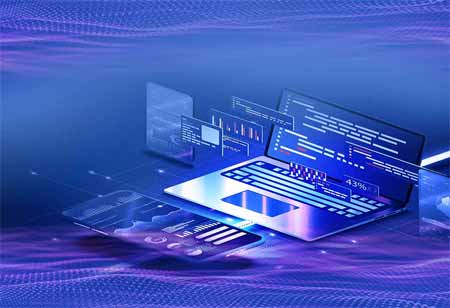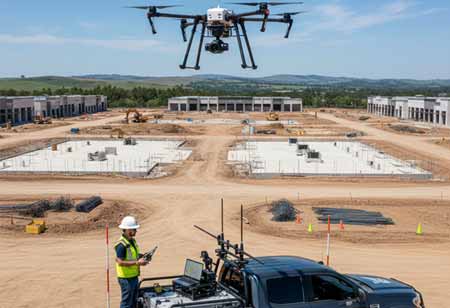THANK YOU FOR SUBSCRIBING
Be first to read the latest tech news, Industry Leader's Insights, and CIO interviews of medium and large enterprises exclusively from Applied Technology Review
Cutting-Edge Technologies to Prevent Derailments
In the realm of long-distance transportation for both passengers and goods, the railway industry plays a pivotal role.

By
Applied Technology Review | Tuesday, October 03, 2023
Stay ahead of the industry with exclusive feature stories on the top companies, expert insights and the latest news delivered straight to your inbox. Subscribe today.
Modern railway technologies, like track sensors, automated braking systems, and predictive analytics, enhance safety, reduce human error, and prevent derailments and accidents, necessitating ongoing investment for continued improvement.
FREMONT, CA: In the realm of long-distance transportation for both passengers and goods, the railway industry plays a pivotal role. The occurrence of derailments presents significant concerns, posing threats to passenger safety, financial stability, and operational continuity. Consequently, mitigating derailments stands as a critical focus within railway operations.
The railway industry has witnessed technological advancements, incorporating state-of-the-art systems and enhancements designed to prevent derailments, thus minimising associated risks proactively. This introductory overview provides a broad perspective on the diverse range of crucial technologies and strategies employed in the railway sector to avert derailments.
Condition-Based Maintenance
Condition-based maintenance revolutionises railway operations management by enabling continuous monitoring of critical train components such as wheels, brakes, and bearings. Adopting real-time data collection significantly diminishes the risk of accidents caused by equipment failures by enabling early detection of potential issues. In contrast to traditional maintenance schedules based on time or mileage, condition-based maintenance optimises the allocation of resources by directing maintenance efforts precisely to where they are most needed, resulting in cost-effectiveness and improved system reliability.
Condition-based maintenance allows railways to enhance safety, reduce maintenance expenditures, and minimise service disruptions. It empowers operators to make informed decisions based on data, proactively address maintenance needs, and better comply with legal regulations. By reducing resource wastage and the adverse environmental impacts associated with maintenance activities, this approach enhances railway systems' overall dependability and safety and aligns with sustainability initiatives. The widespread adoption of condition-based maintenance is expected to grow across railway operations as sensor technology and data analytics continue to advance.
Driverless Trains
A potentially transformative advancement in rail operations and safety is the development of driverless trains. These autonomous train systems offer numerous advantages, even though they are still in the early development and deployment stages.
Remote monitoring enhances security and enables swift response. Driverless trains allow operators and control centres to continuously monitor train performance and track conditions and potential obstacles. In an emergency or unforeseen circumstances, remote intervention becomes an option, facilitating prompt and effective actions to prevent accidents. Ensuring the reliability and safety of autonomous systems and building public trust and confidence in this emerging technology is paramount.
Collision Avoidance Systems (CAS)
A pivotal advancement in railway safety technology involves implementing collision avoidance systems (CAS). These sophisticated systems continually monitor the railway track environment using state-of-the-art sensors like radar and lasers, diligently searching for potential obstacles and other approaching trains. Upon detecting a potential collision risk, CAS systems promptly initiate corrective actions, which include alerting the train operator or automatically engaging the brakes.
Intelligent Speed Adaptation (ISA)
The modern train safety system known as intelligent speed adaptation continuously monitors a train's location, speed, and track conditions using sensors and GPS technology. It aims to enhance safety by adjusting the train's speed in real-time based on the specific characteristics of the track it is traversing, thus preventing accidents such as derailments. ISA ensures trains do not exceed safe speeds when navigating curves, crossing bridges, or encountering other potentially hazardous track-related elements.
Wheel Slide Protection (WSP)
A critical safety mechanism is designed to prevent wheel sliding, reducing the risk of train derailments in railway operations. This technology relies on sensors and real-time data analysis to detect scenarios where wheels may lose traction due to slippery tracks or aggressive braking. When such problems arise, WSP applies brakes to prevent wheel sliding and maintain proper contact between the wheels and the rails.
The primary objective of WSP is to ensure that wheels remain securely in contact with the railway tracks, irrespective of weather conditions or the need for heavy braking. By preventing wheel slides, which lead to a loss of traction and instability, WSP significantly reduces the likelihood of derailments. These systems have proven their effectiveness in enhancing railway safety and are already used in many countries with extensive rail networks. Beyond protecting the train and its cargo, WSP technology contributes to passenger safety and the overall reliability of railway operations.
Positive Train Control (PTC)
A state-of-the-art safety technology has been developed to significantly reduce the risk of train accidents within the railway network. PTC incorporates multiple elements such as GPS, wireless communication, and advanced computer algorithms to achieve its core objectives of averting train collisions, enforcing speed restrictions, and providing safeguards against derailments resulting from human errors or track-related problems.
Intelligent Train Control (ITC)
ITC emerges as a noteworthy advancement in railway safety technology. ITC harnesses artificial intelligence to determine train actions based on real-time data autonomously. It promises to substantially enhance railway safety through its adaptable and proactive approach to preventing derailments and accidents.
Automated Warning Systems (AWS)
A vital component of ensuring safety in the railway sector, AWS play a crucial role in preventing accidents, especially in areas prone to derailments or other hazardous conditions. These advanced systems employ state-of-the-art sensors to monitor a train's proximity to risky areas such as sharp curves or complex track switches. When AWS detects that a train is approaching such areas at an unsafe speed, it promptly issues warnings and, when necessary, initiates emergency braking procedures.
The effectiveness of AWS in averting derailments and other catastrophic incidents cannot be overstated. Providing real-time alerts and corrective actions, AWS is a critical defence against human errors or unforeseen challenges on railway tracks. Its widespread adoption in numerous countries underscores its significance in enhancing railway safety, reducing the likelihood of derailments, and safeguarding the well-being of passengers, railway personnel, and cargo.
Trackside Cameras
Trackside cameras are vital in today's railway safety and monitoring systems. These strategically positioned cameras along railway lines continually observe and assess train movements and track conditions, functioning as vigilant sentinels capable of identifying potential issues or anomalies that could lead to collisions or derailments.
When a trackside camera detects something suspicious, it triggers two crucial responses. Firstly, it alerts the train crew to the problem and provides them with essential information. This rapid communication empowers the crew to take swift and appropriate actions, such as reducing speed or initiating emergency procedures, thus averting potential accidents. Secondly, these cameras connect with the train's control systems, enabling the immediate application of brakes in situations of imminent danger. This significantly enhances the capacity to prevent derailments and accidents.
Rail Condition Monitoring Systems
It represents a pivotal advancement in the realm of rail maintenance and safety. These systems meticulously gauge and assess the condition of railway tracks through a diverse array of sensors. Moreover, they possess the ability to detect the existence of fissures, defects, erosion, and other irregularities that could compromise the structural stability of the track. These systems offer a proactive approach in pinpointing track segments susceptible to derailment or other safety concerns, thus facilitating timely remedial measures. They persistently amass and scrutinise this data for ongoing analysis.
The significance of rail condition monitoring systems lies in their ability to ensure the safety of railway operations and mitigate the risk of accidents. These systems empower railway authorities to initiate targeted maintenance or repair actions by promptly identifying potential issues in real time and issuing notifications, thereby preventing minor problems from evolving into significant safety hazards. These systems are becoming increasingly intricate as technology progresses, incorporating advanced data analytics, machine learning, and predictive modelling to enhance their effectiveness and precision.
Modern railway technologies have significantly enhanced safety measures to prevent derailments and accidents. Advanced track monitoring systems, such as sensors and drones, provide real-time data on track conditions, enabling timely maintenance and repairs. Automated braking systems, like positive train control, mitigate human error and reduce collision risks. Additionally, predictive analytics and artificial intelligence assist in forecasting potential issues, allowing for proactive interventions. These innovations collectively bolster railway safety, ensuring smoother operations, minimising derailments, and preventing accidents, ultimately safeguarding the lives of passengers and the integrity of freight transportation systems. Continued investment in these technologies is essential to improve rail safety further.
I agree We use cookies on this website to enhance your user experience. By clicking any link on this page you are giving your consent for us to set cookies. More info








